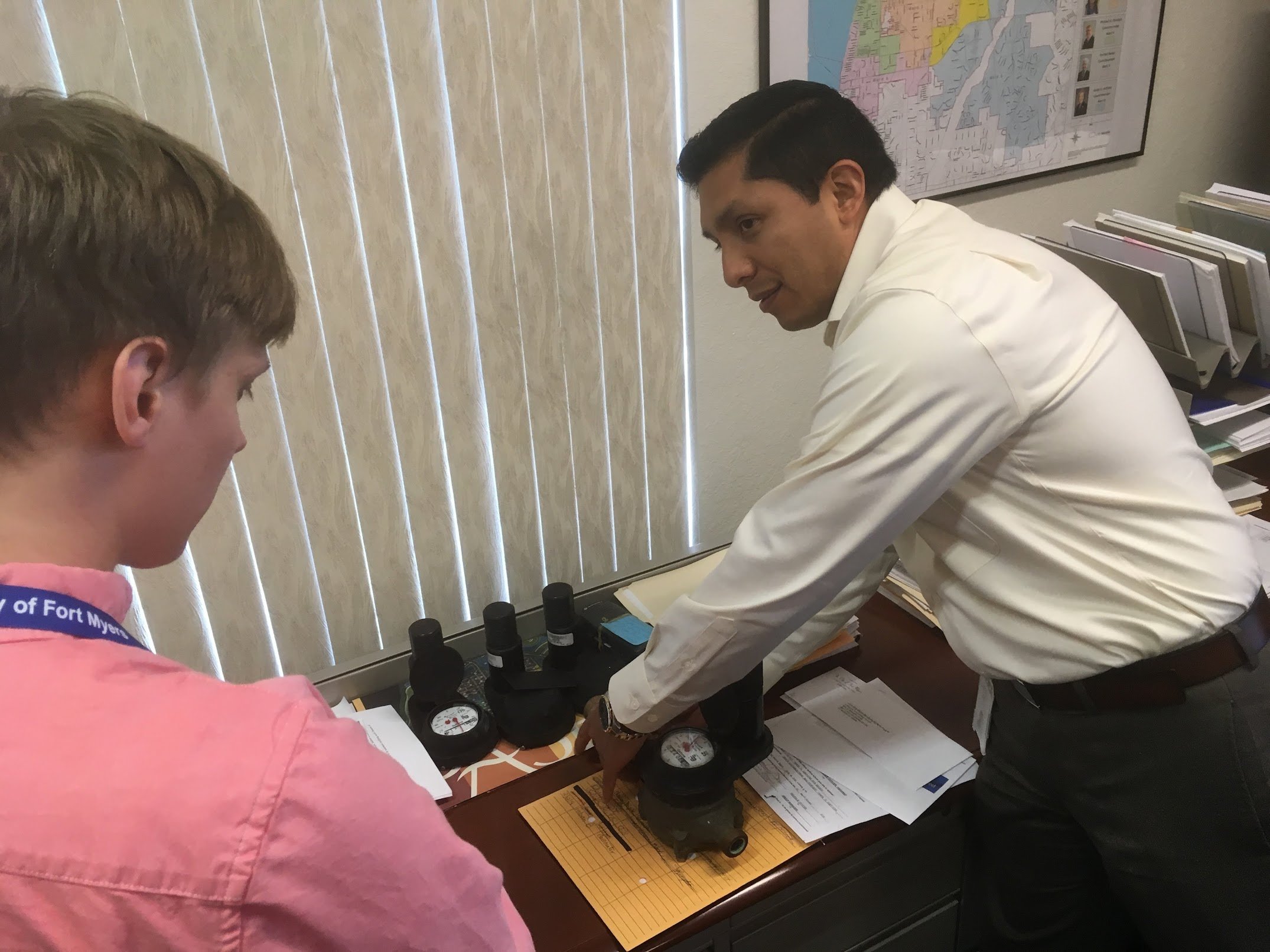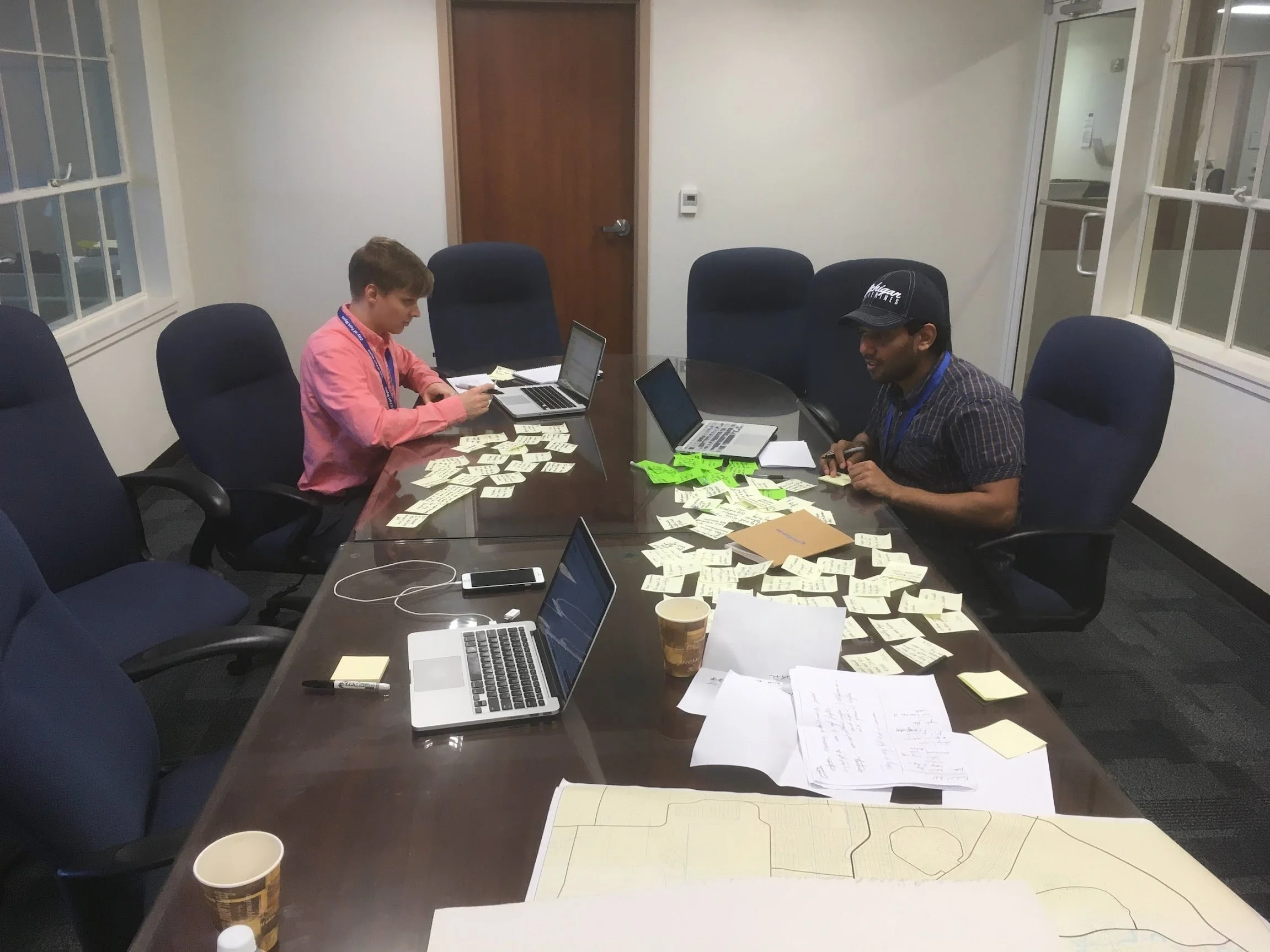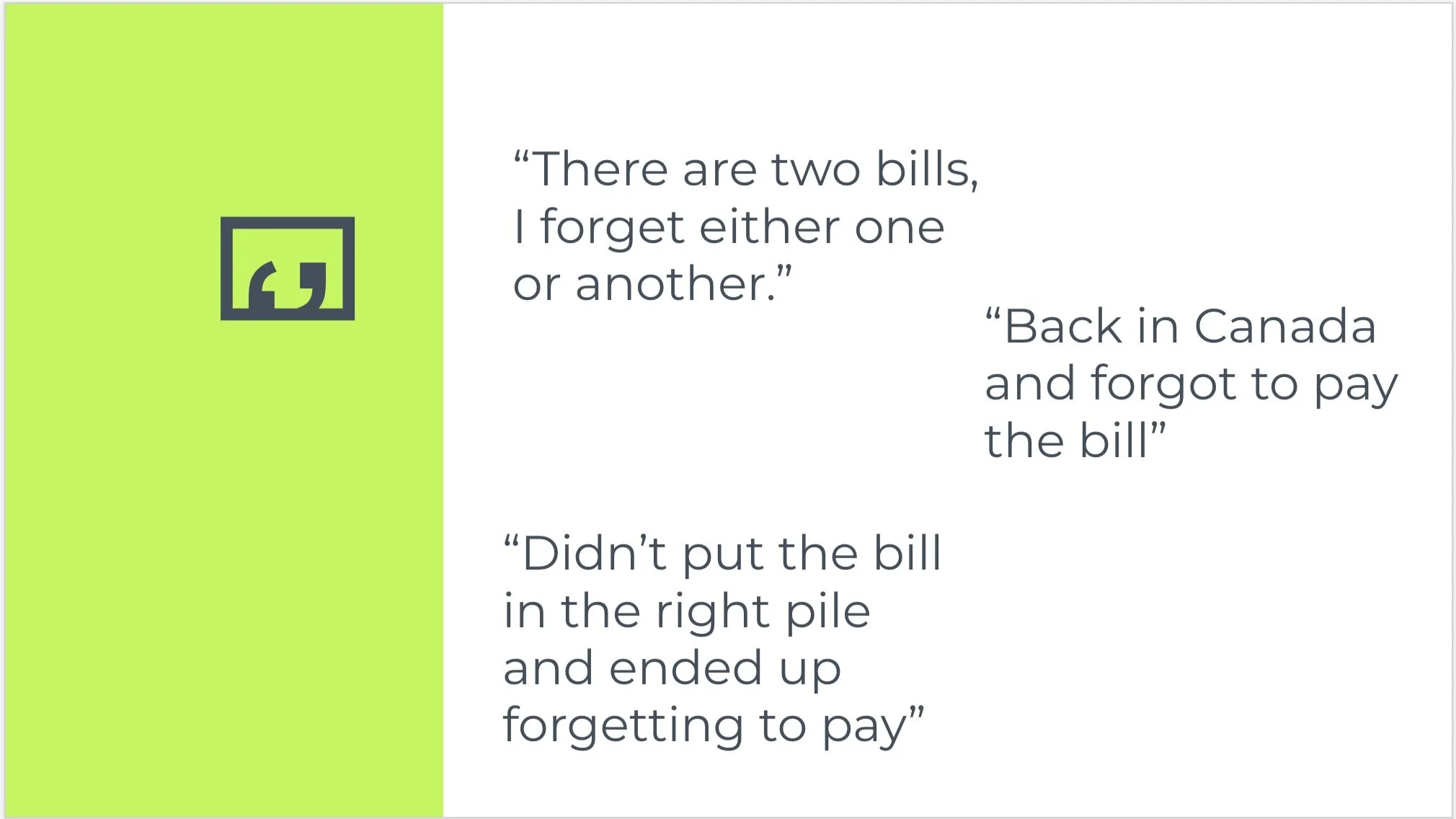BIll Pay Research
Timeline
5 Days | Feb 2018
Client
City of Fort Myers, Florida
Methods
Stakeholder Interviews,
Contextual Inquiry,
Surveys,
User Interviews,
Affinity Diagramming,
Data Visualization
Role
User Researcher
Statistics
900+ Survey Respondents, 20+ interview participants
TL;DR
I conducted research for the city of Fort Myers, Florida to better understand their customers.
Using surveys and semi structured interviews our team gathered data from 900+ users.
We identified problems with the city's communication strategy and billing methods. We recommended digital communication techniques to reduce costs associated with water bill delinquency.
Objective
Conduct guerilla research over the span of 5 days to answer the following:
Why are customers delinquent on their utility bills?
What problems do customers have with current payment methods?
Problem Definition
The city of Fort Myers requested a group of students help them with a unique challenge of understanding bill delinquency. To begin we had to learn as much as we could about the context of the problem. We held stakeholder interviews with the lead members of the billing center.
Key takeaways:
Water in Florida is expensive because it is desalinated
The city is over 100 years old. The infrastructure is aging. This leads to water leaks that customers are still required to pay for
Leaks often go unnoticed because the city only measures every 30 days. This leads to catastrophic expenses ($1k-$5k)
Much of the population only lives there during the winter. This means the city lacks steady funds to improve infrastructure
Unpaid water bills are costly to the city. The city had resorted to turning water off when payments were late to force customers to pay. That process required too many staff resources to sustain.
The city was investing in a new technology to reduce the costs associated with turning water on or off. However they didn’t understand why the delinquency was occurring in the first place.
Process
Problem Definition
Research Plan
Recruitment
Research
Analysis
Report
Research Planning
Our goal was to answer why delinquency was happening. We divided our work into 3 efforts: employee interviews, customer interviews, and customer surveys.
Surveys
With our stakeholders we identified possible hypotheses for delinquency:
Are customers simply facing financial problems?
Do customers lack internet access?
Are there language barriers?
Are some customers not tech literate enough to pay online?
We wanted to compare customers who had had their water shut off with customers who had not. We built a 7 item questionnaire to answer these assumptions. We gathered basic demographics around income levels, device use, english literacy, and forms of payment.
Employee interviews
We only had 2 days to gather information, so we wanted to speak with as many people as possible. We needed to clarify why late bills were so costly. Also how they billed customers, accepted payments, and communicated warnings. We spoke with the head of operations as well as the auxiliary members of his team. Lastly were the call center agents who accepted payments and spoke with customers.
Customer interviews
We held guerilla style interviews with walk in customers to the payment office. Our survey responses gave us a lot of data that needed context. Especially to clarify some of the write in responses that we had encountered. We wanted to actually meet customers who had had their water shut off to learn why it occurred, and any challenges they faced with making payments.
Recruitment
By and large we used convenience sampling to conduct interviews.
Employee access was readily available and participants appeared motivated to speak with us.
Customer interviews occurred at the payment office.
We intercepted customers for about an hour as they came in to pay their bills. We incentivized them with a $10 credit towards their next water bill.
We recruited customers to take our survey through the city’s facebook page as well as en email campaign. We had close to a 10% response rate through email netting 900 survey participants.
Research
Survey results
Because we only had 3 days to capture data, we began data collection in earnest with the survey. We gathered responses for 2 days before closing. 18% of participants (n=164) had experienced having their water shut off by the city. So while delinquency was uncommon, it was still a sizable portion of total participants (n=900). Distribution of income levels was somewhat skewed towards higher values. 40% of participants made over $100k, with 30% between $50k-$100k, and 25% under $50k.
Employee Interviews
We conducted employee interviews on an as-is basis throughout the week. The head of operations and call center agents were our primary informants. Interestingly, some of the call center agents presumed negative intent from their customers. In fact, the call center director believed some customers would procrastinate on purpose. It was a bit surprising to hear this apparent lack of empathy from call center employees.
Customer Interviews
Finally, the customers we spoke to gave rich detail to our research efforts. We identified some novel challenges to getting bills paid from various customers. For example, one recounted having their water shut off twice. She couldn't remember her account number, which made it impossible to make payments online. Also she had two water bills to pay, each from different entities and couldn't keep them straight. She decided it was better to visit the payment office anytime she was nearby, just to check if she had a bill to pay. The lack of transparency was clearly a serious impediment.
Findings
Methods
For all interviews we used affinity diagramming to identify themes and findings. After interviews we held debriefing sessions to review notes and share findings. I analyzed survey data comparing data visualizations from our two target populations. This helped us identify patterns in the characteristics of delinquent accounts.
Analysis
From our analysis we identified two major findings
1. Customers are forgetting to pay their bill
city communication is ineffective
2. Not having accessible autopay amplifies the problem
The online portal is difficult to use
Forgetting to pay
Survey respondents identified many reasons for why their water was shut off. Of note however, 25% said they were unaware or simply forgot about the payment due date. Due to the cities billing practices, customers could have new due dates every month. Furthermore, customers often paid their bills manually. These two factors alone could easily lead to many unpaid bills. The results of our survey highlighted that the city needed better communication strategies.
When the city would notify customers of their delinquency, it would only happen twice. The first notification appeared in their next bill. This we identified was not salient enough because it would appear as just another bill. Without very explicit hierarchy in the document the information could get lost. In short, the customer wouldn't even know something was wrong.
The second notice would give customers 2 days before their water would be shut off. Again this notice would be received through the mail. A delay for any reason (problems with mail carrier, didn't check the mail, etc.) and the customer wouldn't know. It was not only possible but likely that a customer could have their water shut off and not even know. This ineffective communication lead to a widespread lack of awareness.
No accessible autopay
Exacerbating the problems, customers almost always paid their bills manually each month. Whether by phone, online, or in person, over 85% of customers manually paid their bills. This was not always by choice however. Some customers complained to us that the city didn't allow autopay. This was noteworthy because the city did have autopay, but it was poorly marketed and difficult to set up. Customers had to fill out documents and give bank account details at the payment office to do so.
Much of the city messaging marketed the online portal as the preferred means of payment. But customers could not set up automatic payments online. We also identified the online portal as a barrier to some customers due to a lack of technical efficacy. In short, many users were forced to remember their bill due date every month. This ultimately was another factor leading to delinquency.
Report
We presented our final results to the city officials as well as public attendees. We knew our audience would be unfamiliar with UX research. Because of this we focused more on the findings and recommendations, and less on our methods. Many of the findings came as a total surprise to officials and they applauded our work results.
Recommendations
Send out electronic notifications when water bills are delinquent (email, text, etc)
Invest in marketing autopay options, and make it available to set up online
These recommendations didn’t address every problem we identified. However we believed it would have reduced approximately 25% of all delinquent bills. This in turn would substantially reduce their maintenance costs.
We presented our findings to city officials as well as other public attendees and highlighted the problems users had with getting their bills paid on time. We knew this was the first time that city officials had interfaced with UX students, so it was important to interpret the research for them and make results as digestible as possible. Many of the findings came as a total surprise to officials and they applauded our work results.
Challenges & TakeAways
Time constraints were the obvious challenge throughout this project. We had to make tradeoffs between completeness of our methods and gathering information. This made it feel like we were flying and building the plane at the same time. However I learned that regardless how complete your methods, you'll still lose information. This is because as you synthesize, your data has to become more abstract. So the ultimate tradeoff is about the fidelity level of your information. In this case, macro level fidelity was enough to build an effective solution so we didn't need more time.
Although, if more time was allotted I would have focused more on the online portal. A heuristic evaluation could have identified UI specific recommendations to improve the experience. Considering that 75% of customers used the online portal there would have been a lot to address.
Mail by IconPai from NounProject.com, Calendar by Ariyanto Deni from NounProject.com, Water Meter by Made from NounProject.com, Mail Warning by IconPai from NounProject.com, Notice by I Putu Kharismayadi from NounProject.com, Faucet by LAFS from NounProject.com, Forget by Adrien Coquet from NounProject.com, Repeat Payment by Iconiqu from NounProject.com


















